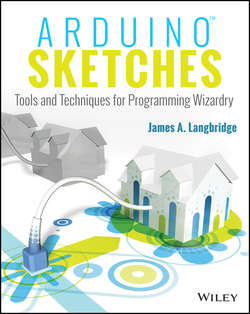Читать книгу Arduino Sketches - Langbridge James A. - Страница 11
На сайте Литреса книга снята с продажи.
Part I
Introduction to Arduino
Chapter 1
Introduction to Arduino
The Arduino Project
ОглавлениеThe Arduino project started in 2005, and was a project for the students at the Interaction Design Institute Ivrea in Ivrea, Italy. Students were taught to use a BASIC Stamp, a small microcontroller device programmable in PBASIC (a variation of the BASIC programming language), but the price for this device (almost $75) was considered to be too expensive for students, not only on acquisition, but also to replace damaged units.
Arduino started as a project for design students, targeted as a replacement for the BASIC Stamp. The Atmel 8-bit AVR was chosen for its simplicity and low price, and had the extra advantage of requiring few external components. It also has an impressive amount of inputs and outputs, making it a perfect choice for future designs.
Students and teachers worked together on a new design, one that used the Atmel AVR and that could easily accept external cards. When the original design was completed, researchers worked to make the design lighter, less expensive and easily usable by students, enthusiasts, and engineers. The first Arduino board was born. Improvements on the Arduino's original design, such as replacing the DB-9 serial connector with USB, has helped expand the platform's appeal.
There are two sides to every Arduino. There is, of course, the hardware, but this is only part of an Arduino project. Every Atmel microcontroller used for Arduino comes with a specific firmware, a small program embedded on every device that looks for a program to run or helps install a program using a serial device.
The final design was released as open source and was designed and sold by Arduino. Releasing Arduino as an Open Source Hardware project was an interesting move. Because it was open source, it attracted more and more users to look into their projects. Because the Arduino already had an excellent input/output design, users began to create boards that could be added to the original Arduino. When Arduino designed a new board, it kept the original input/output layout, enabling existing add-ons to be used with new designs.
Originally designed for education, the Arduino project became famous with electronics enthusiasts, and its boards were sold by more and more distributors.
Arduino not only created the hardware – an embedded device that does not have corresponding software and support programs might still be difficult to use – but also spent a lot of time developing its own language and Integrated Development Environment (IDE). The end result is a nice IDE that can work on Windows, MacOS, and Linux and converts the Arduino language (a high level variant of C/C++) to AVR code. The Arduino development environment hides away all the complications linked to embedded systems and mixing software – such as setting up an environment, linkers, pesky command lines – and lets the developer program using simple C language functions through the Arduino Programming Language.
